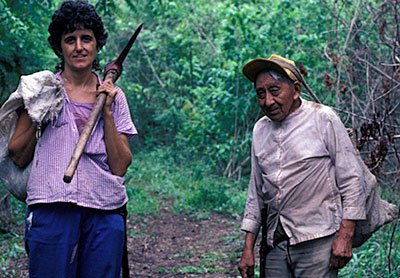Rather than misinterpreting Maya beliefs to falsely predict the end of the world, researching and practicing ancient Maya medicine and natural healing techniques can open a new world of health today, noted author and Maya medicinal plant expert Dr. Rosita Arvigo advised participants at Chaa Creek’s 2012 Maya Winter Solstice celebrations.
Chaa Creek events coordinator Denise Duran said that Dr Arvigo’s presentation, “Tales of a Maya Shaman” was one of the highlights of the Belizean eco resort’s week-long Maya cultural exposition surrounding the 2012 Maya Winter Solstice celebrations of December 21, 2012.
“I think many of the people in the audience were surprised to learn how effective ancient Maya healing practices were, and how relevant they still are today. Dr. Arvigo’s presentation covered a wide range of topics and really inspired people to learn more about Maya healing and how to apply it to their own lives today,” Ms. Duran said.
In 1983 Dr. Arvigo began a 12-year apprenticeship with Don Elijio Panti, a renowned Belizean healer who had been using ancient Maya techniques that combine plants, prayers, massage, acupuncture, and herbal baths since 1931 to treat thousands of patients in the Central American region. He was recognised by the New York Botanical Garden for his “Distinguished Contribution to Science”, and made a Member of the British Empire by Queen Elizabeth II. He died in 1996 at the age of 103.
Dr. Arvigo chronicled her time with him in two of her books, “Sastun: My Apprenticeship With A Maya Healer” and “Rainforest Remedies: One Hundred Healing Herbs of Belize” and has gone on to refine his techniques for a modern audience, especially women, for whom Don Elijio’s treatments were regarded as particularly effective.
“Eventually”, Dr. Arvigo said, “I specialised in ailments of women using these time-honoured bodywork techniques that alleviate and prevent some of our very common complaints. The best part, though, is that it shows there really is an accessible alternative to surgery and drugs for abdominal and pelvis complaints.”
Workshop participants Laura Stegner Pessolano, from Portland, Oregon, and Lisa McElroy from Philadelphia, who attended the 2012 Maya Winter Solstice celebrations with her daughter Abby praised Dr. Arvigo’s talks for opening a new range of affordable and non-invasive health care options.
“This was a particularly valuable presentation in that it showed guests how some very simple, natural and inexpensive techniques can empower them to successfully manage their own health issues. Dr Arvigo emphasises that these ancient techniques aren’t meant to replace modern medicine or doctors, but can certainly be a valuable part of everyone’s health care,” Ms. Duran said.
Dr. Arvigo’s presentation was part of a week-long series of lectures, seminars and workshops held at Chaa Creek as part of Belize’s Maya 2012 Winter Solstice celebrations. Belize’s Maya account for over 12 percent of the population and are having an increasing active voice in national issues such as land management, ecology and social inclusion.
Other noteworthy speakers included archaeologist Dr. Jaime Awe, one of the world’s foremost Mayanists, author David Ruiz, Dr. Allan Moore and Maya flautist and musicologist Pablo Collado.
Chaa Creek proprietor and GM Lucy Fleming hailed the lecture series as a resounding success.
“Dr. Arvigo once again captivated her audience with her real-life journey as a Maya apprentice while imparting some very valuable information along the way. Combined with the presentations from our other expert speakers, our guests received a comprehensive education in Maya history, culture, cosmology and healing. What better way to welcome in the 2012 Winter Solstice and prepare for 2013?
“Chaa Creek will continue to support Maya studies and make our 356-acre nature reserve, which contains scores of Maya archaeological sites and the ancient Maya temple of Tunichilen to legitimate Maya researchers. What was presented at Chaa Creek this week is just the tip of a fascinating amount of Maya information just waiting to be discovered.
“Rather than marking the end of the world, we like to think that the Winter Solstice of 2012 will open up a whole new world of Maya studies for many people,” Ms. Fleming said.
